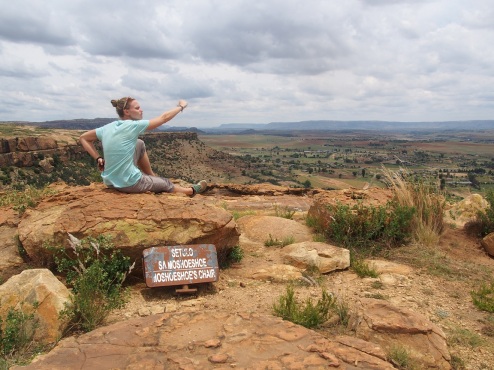Thaba Bosiu was quiet when we reached the top; we could only see one clump of people on the other side of the flat-topped mountain. We looked out over the valley, a patchwork of crops and little houses guarded on all sides by distant mountains.
It was easy to imagine the mountaintop as a sort of bustling village as we followed the paths that led us around to various parts of of the former capital under King Moshoeshoe I in the 1800’s.

Some of the many houses in the Royal Village of Moshoeshoe I. These structures housed Moshoeshoe’s many wives and other members of the royal family.

Traditionally the Basotho people of Lesotho built stone houses in a circular shape. Building square houses was taught to Moshoeshoe I by Europeans in the 1800’s.

Being as Kingly as I could in Moshoeshoe’s Chair, where he sat to watch battles and command his army in the valley below.
The mountain is said to have gained its name- meaning ‘Mountain of the Night’- because of the story that Moshoeshoe I spent almost all night upon arrival securing the mountain and from the belief that it grows so much during the night that it becomes unconquerable. When Moshoeshoe left the plains in 1824 to be far from battling warrior clans, he looked to settle somewhere that would be difficult to capture. The climb to the top is steep, but the flat, open top offered plenty of good grazing and multiple freshwater springs; it was the perfect place to settle. Although the mountain was attacked multiple times, it was never taken. It now serves as a burial ground for Lesotho’s Kings, including Moshoeshoe I.
Thaba Bosiu is one of the most important heritage sites for the people of Lesotho; the first map along the trail notes that “during times of psychological stress and national catastrophes the people of Lesotho look to the mountain for strength, guidance, and inspiration as they strive to uphold the values of freedom, political independence, national unity and cultural identity of their ancestors.”
With perhaps less at stake, Alex and I had gravitated toward the mountains of Lesotho for a bit of strength ourselves, to start recharging our bodies and minds for the year ahead.

Planning a trip to Roma and Thaba Bosiu
Getting there: The first leg of our trip was Maputo to Johannesburg on the overnight Intercape bus. We arrived at Park Station in Johannesburg at 4a.m. It is worth noting that, although we heeded warnings about Jo’burg and Park Station, we felt safe arriving at this hour. There were multiple indoor restaurants open, and the station was well-lit and full of people. We stuck around until well after the sun came up. We then took a taxi to catch a mini-bus to the South Africa-Lesotho border. The bus ride was about 5 hours. We crossed the border by foot, with no Visa cost for U.S. citizens, then got in a shared taxi to the bust station in Maseru. From there we caught a mini-bus about 1 hour to Roma. We got off a little before Roma, at the turnoff for the Roma Trading Post. To get to Thaba Bosiu, we walked the 3 minutes from the Trading Post to the main road and caught a mini-bus going to Maseru. We told them we were going to Thaba Bosiu, and they let us off at the turnoff, where we caught another mini-bus to our destination. Total travel time was less than an hour.

My favorite pal at the Roma Trading Post. I called him Chewy Louie, as he was constantly chewing on all parts of me.
Lodging: We stayed at the Roma Trading Post on the outskirts of the town of Roma. The rooms were in various outbuildings, spread all around the gorgeous garden that filled almost every corner of the property. The lodging was clean and comfortable, and the property was very quiet and relaxed. We had reserved ‘dormitory beds,’ but were pleasantly surprised that this meant being put in our own 2-person rondavel (200 Rand per person per night) with a shared bathroom and access to a kitchen for self-catering. If you plan to cook here, I would recommend going into the town of Roma to buy groceries, as there is only a small, basic market near the trading post. There are no restaurants nearby, but the staff offers home-cooked dinners and breakfasts, as well as complimentary cereal, coffee, and tea for breakfast. There is also a staff member available to lead guided tours of Thaba Bosiu, nearby dinosaur footprints, and other destinations in the region.
Money matters: Lesotho accepts both South African Rand and their own money, the Maloti Rand. These two have the same value and can be used interchangeably in Lesotho. However, the Maloti Rand is not accepted in South Africa, so be sure to spend those first if you take money out in Lesotho. We took money out from ATM’s in Maseru and in Roma.
Other Notes: There is a visitor center in the town of Thaba Bosiu that can arrange guided hikes up the mountain, depending on the season. It costs 40 Rand to do a self-guided walk up, and it took us about 45 minutes to reach the top. The historical site at the top is well-mapped out and it was easy to follow the map and signs to the different areas of interest.
